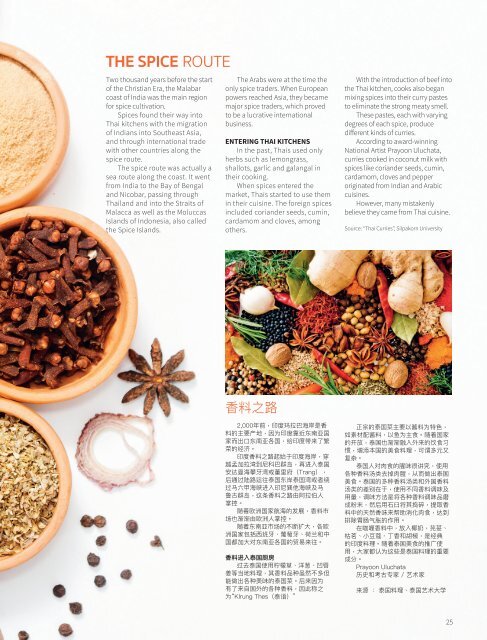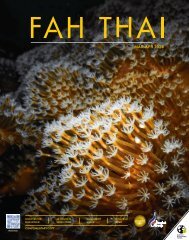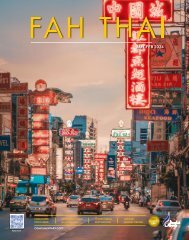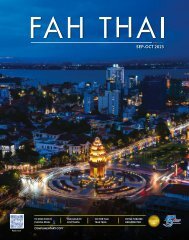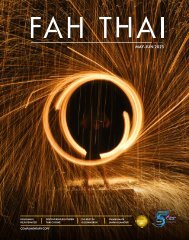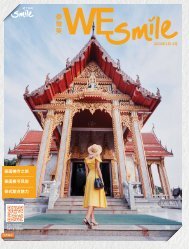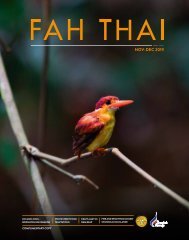You also want an ePaper? Increase the reach of your titles
YUMPU automatically turns print PDFs into web optimized ePapers that Google loves.
THE SPICE ROUTE<br />
Two thousand years before the start<br />
of the Christian Era, the Malabar<br />
coast of India was the main region<br />
for spice cultivation.<br />
Spices found their way into<br />
Thai kitchens with the migration<br />
of Indians into Southeast Asia,<br />
and through international trade<br />
with other countries along the<br />
spice route.<br />
The spice route was actually a<br />
sea route along the coast. It went<br />
from India to the Bay of Bengal<br />
and Nicobar, passing through<br />
Thailand and into the Straits of<br />
Malacca as well as the Moluccas<br />
Islands of Indonesia, also called<br />
the Spice Islands.<br />
The Arabs were at the time the<br />
only spice traders. When European<br />
powers reached Asia, they became<br />
major spice traders, which proved<br />
to be a lucrative international<br />
business.<br />
ENTERING THAI KITCHENS<br />
In the past, Thais used only<br />
herbs such as lemongrass,<br />
shallots, garlic and galangal in<br />
their cooking.<br />
When spices entered the<br />
market, Thais started to use them<br />
in their cuisine. The foreign spices<br />
included coriander seeds, cumin,<br />
cardamom and cloves, among<br />
others.<br />
With the introduction of beef into<br />
the Thai kitchen, cooks also began<br />
mixing spices into their curry pastes<br />
to eliminate the strong meaty smell.<br />
These pastes, each with varying<br />
degrees of each spice, produce<br />
different kinds of curries.<br />
According to award-winning<br />
National Artist Prayoon Uluchata,<br />
curries cooked in coconut milk with<br />
spices like coriander seeds, cumin,<br />
cardamom, cloves and pepper<br />
originated from Indian and Arabic<br />
cuisines.<br />
However, many mistakenly<br />
believe they came from Thai cuisine.<br />
Source: “Thai Curries”, Silpakorn University<br />
香 料 之 路<br />
2,000 年 前 , 印 度 玛 拉 巴 海 岸 是 香<br />
料 的 主 要 产 地 , 因 为 印 度 靠 近 东 南 亚 国<br />
家 而 出 口 东 南 亚 各 国 , 给 印 度 带 来 了 繁<br />
荣 的 经 济 。<br />
印 度 香 料 之 路 起 始 于 印 度 海 岸 , 穿<br />
越 孟 加 拉 湾 到 尼 科 巴 群 岛 , 再 进 入 泰 国<br />
安 达 曼 海 攀 牙 湾 或 董 里 府 (Trang),<br />
后 通 过 陆 路 运 往 泰 国 东 岸 泰 国 湾 或 者 绕<br />
过 马 六 甲 海 峡 进 入 印 尼 巽 他 海 峡 及 马<br />
鲁 古 群 岛 , 这 条 香 料 之 路 由 阿 拉 伯 人<br />
掌 控 。<br />
随 着 欧 洲 国 家 航 海 的 发 展 , 香 料 市<br />
场 也 渐 渐 由 欧 洲 人 掌 控 。<br />
随 着 东 南 亚 市 场 的 不 断 扩 大 , 各 欧<br />
洲 国 家 包 括 西 班 牙 、 葡 萄 牙 、 荷 兰 和 中<br />
国 都 加 大 对 东 南 亚 各 国 的 贸 易 来 往 。<br />
香 料 进 入 泰 国 厨 房<br />
过 去 泰 国 使 用 柠 檬 草 、 洋 葱 、 凹 唇<br />
姜 等 当 地 料 理 , 其 香 料 品 种 虽 然 不 多 但<br />
能 做 出 各 种 美 味 的 泰 国 菜 。 后 来 因 为<br />
有 了 来 自 国 外 的 各 种 香 料 , 因 此 称 之<br />
为 “Klrung Thes( 泰 语 )”<br />
正 宗 的 泰 国 菜 主 要 以 酱 料 为 特 色 ,<br />
如 素 材 配 酱 料 , 以 鱼 为 主 食 。 随 着 国 家<br />
的 开 放 , 泰 国 也 渐 渐 融 入 外 来 的 饮 食 习<br />
惯 , 增 添 本 国 的 美 食 料 理 , 可 谓 多 元 又<br />
复 杂 。<br />
泰 国 人 对 肉 食 的 腥 味 很 讲 究 , 使 用<br />
各 种 香 料 汤 类 去 掉 肉 腥 , 从 而 做 出 泰 国<br />
美 食 。 泰 国 的 多 种 香 料 汤 类 和 外 国 香 料<br />
汤 类 的 差 别 在 于 , 使 用 不 同 香 料 调 味 及<br />
用 量 , 调 味 方 法 是 将 各 种 香 料 调 味 品 磨<br />
成 粉 末 , 然 后 用 石 臼 将 其 捣 碎 , 提 取 香<br />
料 中 的 天 然 香 味 来 帮 助 消 化 肉 食 , 达 到<br />
排 除 胃 肠 气 胀 的 作 用 。<br />
在 咖 喱 香 料 中 , 放 入 椰 奶 , 芫 荽 、<br />
枯 茗 、 小 豆 蔻 、 丁 香 和 胡 椒 , 是 经 典<br />
的 印 度 料 理 。 随 着 泰 国 美 食 的 推 广 使<br />
用 , 大 家 都 认 为 这 些 是 泰 国 料 理 的 重 要<br />
成 分 。<br />
Prayoon Uluchata<br />
历 史 和 考 古 专 家 / 艺 术 家<br />
来 源 : 泰 国 料 理 、 泰 国 艺 术 大 学<br />
25


